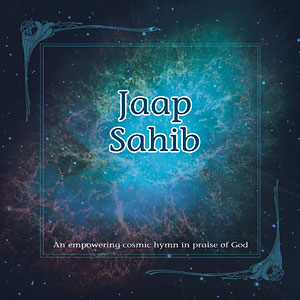 Jaap Sahib morning prayer of Sikhs by Guru Gobind Singh, is an Ode to Ek Ongkar, One Divine light. These are my experiences and thoughts on the bani and recitation together with an attempt at translation and transliteration of it.
Jaap Sahib morning prayer of Sikhs by Guru Gobind Singh, is an Ode to Ek Ongkar, One Divine light. These are my experiences and thoughts on the bani and recitation together with an attempt at translation and transliteration of it.
As Khalsa Sikhs we are advised to do certain prayers on a daily basis, some in the morning and some in the evening and night. For the longest time, bringing myself to wake up earlier than usual and reading the banis seemed like a major task and I would get lazy. More so, I considered it almost a chore, a ritual to be performed because it was “required”. However, a part of me always said that there was a lot more to bani or composition than is immediately apparent and it will take some sincere effort to figure it out. So, a little while back I started waking up earlier than usual and after the daily meditation, started reciting the Japji and Jaap Sahibs.
A lot of times I have seen that the bani is read or recited quickly without really understanding or even listening to the words and felt that this gave it a ritualistic flavor. Determined not to fall into that, I started reciting slowly, enunciating each word and letting the sounds linger. Not only was I able to grasp the meanings of certain words, the sound vibrations reverberated in my head, so much so that sometimes I could feel it for hours after the recitation. Now, I still don’t understand most of the bani, but figured it will come over time and in the meantime lets enjoy the sounds, tempo and rhyme. More details and description of Jaap Sahib can be found here. What I found interesting is that the introduction of each major part has a line which in my opinion partly indicates its rhythm, for example, the Bhujang Prayat Chaand which I think refers to the way a Snake moves or the Madhubhar Chand, or Sweet Honey stanzas that should be read lovingly. Then there are words where the tongue touches the palate creating the sounds of “tng”, “twng”, “bhng” etc. which I can feel have a special reason but haven’t fully understood it yet.
Also, I feel that this is one of the prayers, bani, path that needs to be read in it is original form to get its essence as the sounds and vibrations are so important. This is just personal experience and maybe other people have experienced this too. During and after the recitation of Jaap Sahib, I feel a heat wave through my spine and it varies based on my state of being that day and how engaged I’m in the bani. The closest I relate this feeling to is the movement of prana in Kundalini Yoga where it is said there there are 7 energy centers concentrated at different spots along the spine. A little while back, there was a feeling of intense heat at the back of neck, so much so that my skin developed a boil that lasted for weeks. The other downside is that I sweat more sometimes. Ok seriously, but I do feel a difference in my energy levels during the day when I did recite Jaap Sahib in the morning and the days I didn’t. An investment of 25 minutes in the morning probably saves me at least an hour during the day in thinking and action time. Again, I haven’t gotten this down to an exact science, but it seems all very rational and is getting there.
For people who don’t read or understand Gurmukhi or Punjabi, I do recognize that some words can however, be very complex and difficult to pronounce as they are drawn from languages like Sanskrit, Brij Bhasha, Urdu and Arabic. Below is an attempt to transliterate and translate the Jaap Sahib in easy to read English so that a wider audience can enjoy it. Please follow these rules, to aid in the correct, phonetic pronunciation of the transliteration from Gurmukhi to English below:
* The characters “tng”, “twng”, “bhng” are used to denote 'sound syllables' and not letters and are pronounced by touching the back of the tongue to the back of the throat and producing something like “anngg” sound.
* Some letters have no equivalent in English, for example, “adh” is pronounced by flipping the tongue by touching the palate and then slamming it down
* The characters “tt” signify a strong “Tea” like sound where the tongue rolls and touches the palate. However “th” is pronounced by touching the tongue to the teeth and not the palate.
This is just the beginning, I realized it will take me a lot longer than originally thought as I really want to make sure the translation is correct and have to consult with my Grandfather who lives in Delhi. Do let me know what you think, any feedback is welcome.
Jaap Sahib
Ek Ongkar Satgur Prasad
|| Jaap ||
Sri Mukhvak Patshahi 10
Chhapae chand || Tav Prasad
| Chkr chihn arr barrn jat arr paath nihn jeh. Rroop rang arr rrekh bhekh koeo kah na sakkat keh. Achall moorath anbhau prakas amithoj kahijae. Kot indr indraandh saah sahaandh gadhinjae. Thribhavndh maheep sur nar asur neth neth ban trindh kahth. Tw sarb naam kathae kavn karm naam barnat sumt ||1|| |
Form, symbol, caste, lineage are none. Persona, hue, shape, form can say none. |
|
Bhujang Prayaat Chand Namastwng Akaale Namastwng Kripale Namastng Arupe Namastng Anupe ||2|| Namastng Abhekhe Namastng Alekhe Namastng Akae Namastng Ajaae ||3|| Namastng Agnje Namastng Abhnje Namastng Aname Namastng Atthame ||4|| Namastng Akarmng Namastng Adharmng Namastng Adhamng ||5|| Namastng Ajeete Namastng Abheete Namastng Abahe Namastng Addhahe ||6|| Namastng Aneele Namastng Anadhe Namastng Achedhe Namastng Agaddhe ||7|| Namastng Aganje Namastng Abhanje Namastng Abheje Namastng Udare Namastng Adhare ||8|| Namastng Anekae Namastng Anekae Namastng Abhute Namastng Ajupe ||9|| Namastng Nrikarme Namastng Nribharme Namastng Nridhese Namastng Nribhese ||10|| |
